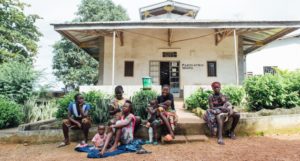
I never met Dr. Wouter Nolet.
The 90 minute drive into the African bush, to visit Masanga Hospital, was not pleasant. My colleague, a plastic surgeon from Ireland, had arranged for the four of us to make the journey in the back of a small ambulance, as the Land Rover, owned by the Holy Spirit Hospital, had recently broken down. Indeed, a very small ambulance it was. About every 15 minutes of jostling and bouncing through large puddles and brush, on the dirt roads, one of us would complain of motion sickness and we would have to stop the vehicle and alternate from sitting on the collapsed stretchers in the short ambulance bed, to sharing the one available seat in the cab with the driver. To add to the misery, both the 6 inch red welt on my neck and the weeping ulcer in the back of my left ear, were constantly itching and stinging, thanks to recent encounters with the Nairobi fly. The incessant sweating from the mid-day hot, humid, tropical sun was not helping matters.
Upon arrival, we were greeted by 2 of the 4 European physicians who staffed the hospital and they immediately asked us to evaluate a wound on a young man. There was no doubt that the boy’s leg was badly infected as, from our years of clinical experience, we could smell Pseudomona aeruginosa from about 20 paces. What had apparently, started out as a small tropical ulcer on this boy’s lower leg, had now progressed to a large wound encompassing the entire outer aspect of his leg from his ankle to above the knee. Unfortunately, due to the greenish color on the wound’s borders, there was little hope that the patient would eventually not lose the leg to an amputation.
Opened in the 1960’s, Masanga Hospital had gained repute as a Leprosy treatment center. During the Blood Diamond Civil War (1991-2003), it was taken over and used as a base by the rebel soldiers of the United Revolutionary Front and due to neglect and destruction, the institution stopped seeing patients in 1997. In 2006, the hospital was restored and shortly became operable under a joint project between Masanga, Denmark and the Sierra Leone government. The management was eventually assumed by a Norway-based charity CapaCare, and currently serves as a nursing and surgical training center with 120 beds, treating over 12,000 obstetric, surgical and pediatric patients per year.
As representatives of a medical non-profit foundation, Surg+Restore (US 501c3), the purpose of our visit was to establish partnerships in health care education and training and set up a system for the medical care of burn patients and anesthesia training. Sierra Leone consistently ranks among the 7 poorest countries on the planet and has the highest maternal mortality rate and the tenth highest infant mortality in the world. In addition, infectious diseases are rampant. Sierra Leone suffered the highest number of deaths (over 4,000) during the Ebola epidemic of 2014 -16. Furthermore, Malaria is responsible for over 20% of all infant deaths under the age of 5 years old and the prevalence of HIV/AIDs in the population is over 1.7%. Other endemic diseases in the country, which have been mostly eradicated in the developed world, include Yellow fever, Zika virus, Lassa fever, tuberculosis, leprosy, typhoid fever, Schistosomiasis and others commonly known as “elephantiasis” and “river blindness”.
As we were winding up our visit at Masanga hospital, we were introduced to another one of their physicians from the UK who had just returned from the country’s capitol, Freetown, where he had transported a Dr. Wouter Nolet to the airport for air evacuation to Holland. Dr. Nolet was the Program Coordinator for Capacare in Sierra Leone and the leader of Masanga Hospital staff. Apparently, he had been feeling ill for over a week despite rest and antibiotic treatment.

Lassa fever is a viral hemorrhagic fever caused by the Lassa virus, which is similar to but much less virulent than the Ebola virus. Human infection is most commonly caused by contact with food that has been exposed to the urine and feces of infected rats. Unlike an airborne virus, such as the Corona virus, Lassa can also be transmitted between people from exposure to body secretions, such as through surgical procedures, if there is a break in sterile protocol. The disease is endemic in parts of Sierra Leone, Ghana, Liberia, Guinea and Nigeria with about 500,000 humans infected annually and a mortality rate of more than 1%. Women who contract the virus in their 3rd trimester of pregnancy have an 80% mortality, accompanied by fetal demise. There is no vaccine available.
Dr. Wouter was known for his professionalism, knowledge and passion to teach and advance surgical care in Sierra Leone. He and his team at Masanga Hospital demonstrated the same courage, discipline and benevolence set forth by other physicians and medical professionals who sacrifice the comforts of developed countries to donate their professional skills in sub-Saharan Africa. Endeavors that are definitely not without their risks.
I never met Dr. Wouter Eric Nolet.
He was 32 years old.
– Robbie Cree
Oporto and Di Monki Waka are original psychedelic Afro-Latin rock compositions by my Portland-based band, Ojos Feos, that are played behind African highlife and reggae rhythms, respectively. “Oporto”, is a Sierra Leone Krio language word for “strange” or “foreign”. It is also commonly used as reference for “white man” or “foreigner” throughout the country. The songs were composed to represent the state of the economic condition and daily life in Sierra Leone, after enduring both the 13 year Blood Diamond Civil War and the 2 year Ebola virus epidemic (2014-2016). The lyrics admit to the atrocities of the past, with acknowledgement that the country has rebounded but the path ahead will not be easy. Optimism is portrayed in the uplifting tone and melody of Di Monki Waka. The songs also affirm that Sierra Leone will need assistance from the developed world, similar to the ongoing efforts of international medical NGOs such as CapaCare and Surg+Restore.
Oporto
Oporto
Wi dae wait
Fo
Una elp


